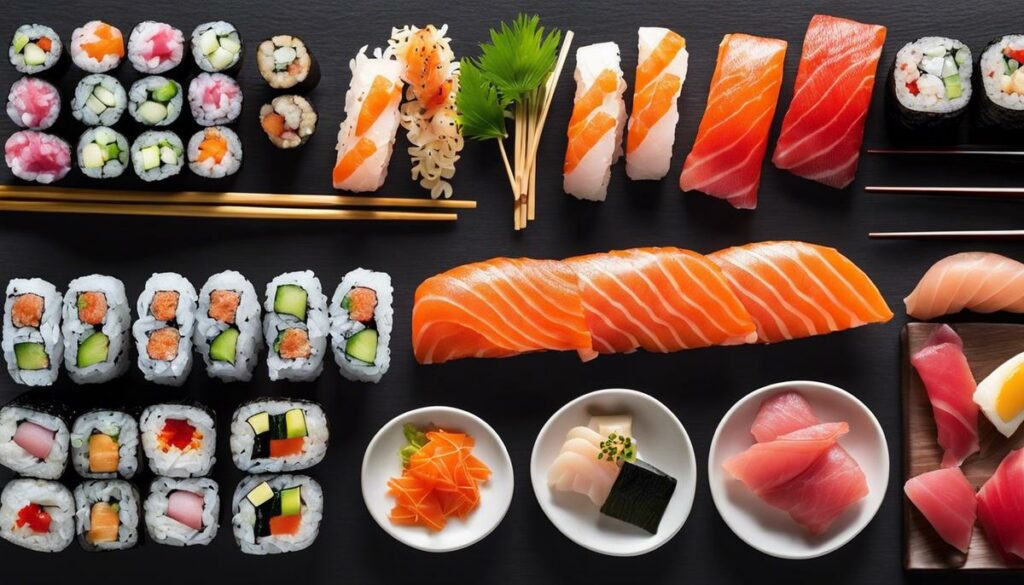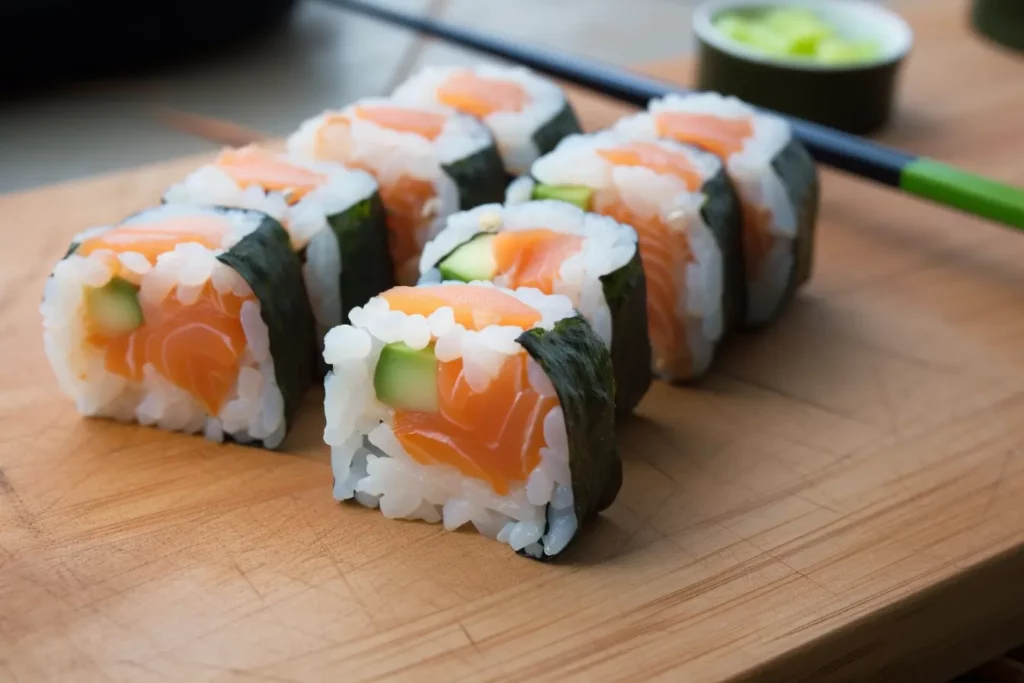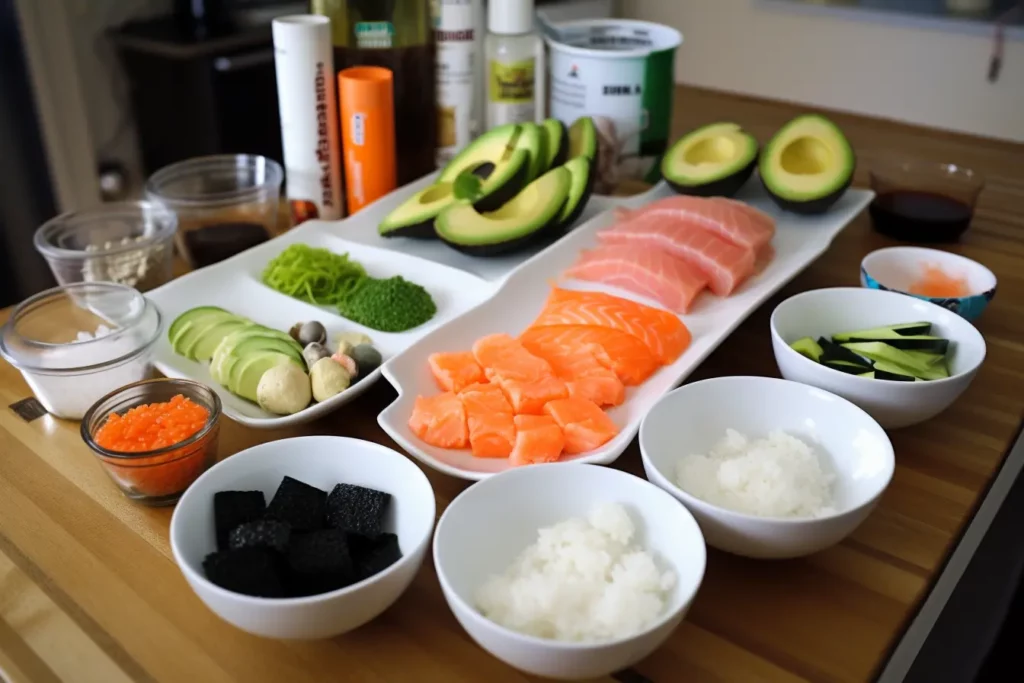Sushi, originally a simple prepared meal to preserve fish, has undergone a remarkable transformation to become a global culinary delight and a symbol of refined cuisine. A deep look into the history of sushi reveals a journey that spans thousands of miles and centuries as it evolves from its humble roots in Southeast Asia to become an international favorite. The seductive interplay of taste, texture and aesthetics that characterizes sushi has significantly influenced not only our palate, but also gastronomy worldwide.
History of Sushi
The culture and history of sushi has undoubtedly had a profound impact on modern gastronomy worldwide. This circular wonder from Japan, a perfect symbiosis of craftsmanship and creativity, is changing the way we look at and experience food.
The magical world of sushi began as a simple method of preservation. In the Yayoi period in Japan (about 300 BC to 300 AD), rice was used to ferment fish. This ancient technique has evolved over the centuries until the Edo period (1603 to 1868) saw the emergence of a faster fermentation process. This was the beginning of the “nigiri” style as we know it today.
And basically, that’s also the fascinating story of why we think of sushi as an art. It requires precision, skill, and a clear understanding of aesthetics. Sushi is much more than just a dish – it also embodies the culture and tradition of Japan, which gives it its special place in the gastronomy world.
The impressive palette and complexity have meant that sushi is widely used in today’s pop culture. Not only does it serve as a visually appealing Instagram photo, but it’s also a source of culinary innovation. From the traditional “nigiri” to the Western-influenced “california roll” to the more experimental “sushi burritos,” sushi always remains relevant and continues to give us new perspectives on an ancient art form.
The popularity of sushi has also helped foster a movement towards a healthier and more conscious way of living. The risk of heart disease, high cholesterol, etc. can be reduced solely by following a diet based on raw fish, rice and vegetables. It’s a clear sign of how much our eating habits can affect our health.
The global acceptance and spread of sushi speaks volumes about our ability to connect and learn across cultural boundaries. Sushi has revolutionized the way we look at and enjoy food, and it continues to be a vibrant part of our ever-changing culinary landscape.

Photo by epicurrence on Unsplash
Sushi & Health Awareness
Sushi plays a crucial role in the current balanced and conscious nutritional trend. Thanks to its raw food ingredients with high vitamin and mineral content and low fat content, sushi has gained a place of honor among the health-conscious of its audience.
It’s no secret that fish rich in omega-3 fatty acids, which reduce the risk of heart disease, has recently been introduced. Sushi packs the taste of the sea with seafood, often in raw form, in a small, fine presentation. Vegetables also play a key role in sushi designs. Each piece is often filled with fresh ingredients, such as cucumber, avocado or pickled daikon, which contribute an abundance of nutrients.
In addition, sushi is traditionally prepared with rice enriched with vinegar . This practice gives the rice a sweet and savory flavor, but also allows for a slower absorption of sugar into the bloodstream. The result is stabilized blood sugar levels, which is especially important for individuals with diabetes.
Another notable ingredient of sushi is wasabi. Often served on sushi plates, this little green paste is actually a plant that offers a number of health benefits. In addition to tasting spicy, wasabi is a natural antioxidant and has antimicrobial properties that help fight bacterial infections.
However, when consumed in excess, rice and fish also have negative effects on health due to their nature. Therefore, it is important that sushi is consumed in moderation and thus its healthy properties can be used in the best possible way.
The result is an image of sushi that is not only aesthetically pleasing, but also incredibly healthy. Sushi combines simplicity with elegance in a way that helps create a superior dining experience. It makes a significant contribution to healthy eating by combining taste, texture and color in a way that both satisfies and nourishes.
In this hectic and rapidly changing world, it is refreshing to see that we can reflect on the fine tastes and conscious eating habits presented to us through the sushi example. It’s a philosophy of eating to be cherished.

Sushi as luxury and gourmet cuisine
A delicious gourmet option and favorite among the world’s culinary gourmets, sushi is undoubtedly more than just a meal. It is a combination of flavors and textures that offers a true sensory experience based on the centuries-old traditions of Japan. But what exactly is it that makes this seemingly simple dish of fish and rice one of the true stars of luxury cuisine?
First of all, there is the quality of the ingredients. High-quality sushi rice is essential and is not only used for filling, but also provides a perfect texture base for the overall experience. The same goes for the fish, which is at the heart of every sushi creation. Only the freshest and best fish are used in the sushi production, which adds to the exclusivity and luxury association of the dish.
However, it is not only the quality of the ingredients that makes an excellent sushi, but also the artful preparation. A sushi master needs years of practice and talent to understand and master the intricacies and nuances of each part of the making. This dedication and craftsmanship are presented to the connoisseur in every balanced bite.
It should also not be forgotten that sushi in combination with the right beverage accompaniment makes for an exquisite gourmet experience. Whether it’s a traditional green tea or a well-chilled sake, the combination of sushi and drink can offer a taste experience of superlatives.
In the modern world, where awareness of healthy eating is at an all-time high, sushi is becoming even more important. As a nutritious option, it appeals to both the health-conscious and foodies, uniting these two groups.
In conclusion, it can be said that sushi is not only a luxurious pleasure, but also a symbol of the union of taste, appearance and healthy eating. With every roll and bite, the sushi master shares a piece of his passion and artistry. It is this demand for excellence and perfection that makes it an outstanding star in the world of luxury gastronomy. This is something to keep in mind the next time you have a fine selection of sushi in front of you. It’s much more than just a meal – it’s a lifestyle in a class of its own.

Influence of sushi on international gastronomy
The world of world-class gastronomy is an ever-growing and changing field, and sushi has established itself as a leading dish in this luxurious field. The fine-tuning of flavors and textures that can be found in each sushi creation is a testament to the artistry and dedication that goes into its elaboration.
The company’s own standards for sushi are high. From the selection of high-quality ingredients to the art and craftsmanship of preparation, every detail plays a crucial role in the ultimate indulgence experience. One of the main elements that plays a key role in any type of sushi is the rice. It forms the base and supports the flavors of the other ingredients.
Fresh and high-quality fish is an absolute must. From selection to preparation, the sushi master is responsible for preserving and highlighting the natural flavors. This aspect gives sushi its special unique selling point in gastronomy.
Tea or sake? A wise choice of drink can take the sushi experience to a new level. Each drink has special nuances that can bring out certain flavors of the sushi and contributes to a well-rounded, harmonious meal.
Sushi appeals not only to gourmets, but also to health-conscious people. Its natural ingredients, along with the absence of processed foods, make it a top-notch choice for those looking for high-quality food and a conscious diet.
There is more to the experience of eating sushi than just aesthetic appeal. It also reflects the taste and pursuit of healthy food. The passion and artistry that goes into making a sushi dish is a testament to the respect and love for the subtlety of Japanese culture.
Enjoying sushi is not only a sensory experience, but also a lifestyle choice. It reflects an appreciation for fine dining, an enthusiasm for aesthetics, and a conscious choice for health and wellness. Enjoying sushi is a moment of silence and mindfulness that offers a welcome change of pace in today’s busy world.

The way sushi has influenced international gastronomy is a testament to its enduring global appeal and cult status. Its presence has shaped gastronomy of different regions and allows us to recognize the fusion of cultures, techniques and flavors. Sushi has managed to combine healthy food with gourmet cuisine in a sublime way, thus paving the way for a conscious lifestyle. Plus, it has found its place firmly in luxury and high-end cuisine, with chefs continuing to push its boundaries and reinterpret it. This shows the enduring and universal appeal of sushi and its transformative effect on the world of gastronomy.


